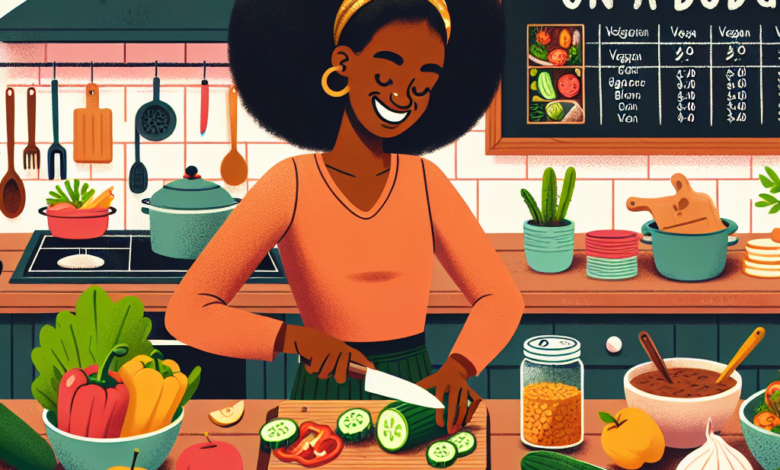Vegan on a Budget: Eating Well Without Breaking the Bank

Adopting a vegan lifestyle can seem daunting, especially when it comes to keeping your grocery budget in check. However, with some planning and creativity, eating a delicious vegan diet doesn’t have to be expensive. Here are tips and ideas to help you thrive on a budget while enjoying nutritious, plant-based meals.
1. Understand Your Staples
The foundation of a budget-friendly vegan diet lies in knowing which staple foods to stock up on. Here are some economical choices:
- Legumes: Lentils, chickpeas, and beans are protein-packed and versatile. They can be used in soups, salads, and stews or made into delicious spreads like hummus.
- Whole grains: Rice, quinoa, oats, and whole grain pastas are filling and affordable. They provide essential nutrients and can serve as the base of many meals.
- Seasonal vegetables: Buy vegetables that are in season and on sale. Root vegetables, leafy greens, and cruciferous veggies are generally cost-effective.
- Frozen produce: Frozen fruits and vegetables are often cheaper than fresh, and they have a longer shelf life. They’re perfect for smoothies, stir-fries, and soups.
2. Embrace Meal Planning
Meal planning is a powerful tool for staying within your budget. Here’s how to get started:
- Create a weekly menu: Outline your meals for the week and make a shopping list based on those meals. This helps avoid impulse buys and wasted food.
- Batch cooking: Prepare meals in bulk and store them for later. Dishes like chili, curries, and casseroles freeze well and can be reheated easily.
- Theme days: Assign themes to each day of the week (e.g., Meatless Monday, Taco Tuesday) to simplify planning and make grocery shopping easier.
3. Shop Smart
Where and how you shop can make a significant difference in your expenses:
- Local markets: Check out farmers’ markets or co-ops for fresh produce at a lower cost. Buying directly from farmers can save you money while supporting local agriculture.
- Bulk bins: Buy grains, nuts, seeds, and dried fruits from bulk bins. This usually costs less per pound than packaged items and helps reduce food waste.
- Store brands: Opt for store brand products rather than name brands. They often have similar quality but come at a lower price.
4. Utilize Plant-Based Proteins
Plant-based proteins are not only nutritious but can also be more affordable than meat or dairy alternatives:
- Tofu and tempeh: These soy products are rich in protein and can be used in various dishes, from stir-fries to scrambles.
- Seitan: Made from wheat gluten, it’s a low-cost meat substitute that absorbs flavors well.
- Nuts and seeds: Although pricier, a little goes a long way. Use them sparingly for added nutrition and crunch in meals.
5. Keep It Simple
Minimalist cooking can save time, effort, and money. Here are some tips for simplicity:
- One-pot meals: Create meals that require minimal preparation and cleanup, such as stir-fries, soups, and stews. They are also a great way to use up leftover veggies!
- Flavor boosters: Use spices, herbs, and condiments to enhance your meals without needing to spend a lot on ingredients. A few well-chosen items can elevate a simple dish.
6. Get Creative with Leftovers
Don’t let leftovers go to waste. Here are some creative ways to use them:
- Repurpose meals: Use leftover grains as the base for a salad or add them to soups for extra heartiness.
- Make wraps and sandwiches: Utilize leftover veggies, grains, and proteins to create satisfying wraps with your favorite sauces.
7. Explore Online Resources
Take advantage of the plethora of online resources that cater to budget-friendly vegan meals:
- Recipe websites and blogs: Many sites offer recipes sorted by price per serving, allowing you to choose meals that fit your budget.
- YouTube channels: There are countless cooking channels dedicated to budget-friendly vegan meals, complete with demonstrations that make the process easier.
Conclusion
Eating vegan on a budget is entirely achievable with a little planning and creativity. By focusing on staple ingredients, embracing meal planning, shopping smart, and getting inventive in the kitchen, you can enjoy healthy, delicious, plant-based meals without overspending. Remember that living a vegan lifestyle is not just about the food you eat—it’s about making choices that align with your values while being kind to your wallet. Happy cooking!
